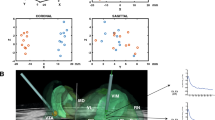Summary
Based on Benabid's experimental and clinical findings that low-frequency (50 Hz) electrical stimulation of the ventral intermediate thalamic nucleus may increase tremor, while higher frequencies (>100 Hz) lead to suppression of the tremor, we implanted a stimulation electrode in 33 thalami among 27 patients. Six patients were implanted bilaterally. 23 suffered from Parkinson's disease, 4 from essential tremor. All patients had a drug-resistant tremor.
The Vim target was calculated based on stereotactic ventriculography. An intra-operative neurophysiological target control was performed on all patients. After a monopolar (12 thalami) or quadripolar (21 thalami) lead was implanted we then connected it to a percutaneous extension lead. In the days following the surgery a test stimulation was performed. In all but one patient stimulation resulted in a suppression of the tremor. In a second procedure, a pulse generator (ITREL II; MEDTRONIC) was implanted and connected subcutaneously to the thalamic lead.
After implantation of the pulse generator all patients stimulate chronically while some turn off the stimulator at night. In 21 thalami total suppression of tremor was observed, 6 showed major improvement, 4 only minor improvement. There was no significant effect on any other existing symptom of Parkinson's disease.
Due to the proximity of Vim to the sensory thalamus the majority of the patients (27 thalami) report slight temporary paraesthesias when the pulse generator is turned on. Two report permanent paraesthesias when stimulation is on. In 4 cases a slight dysarthria occurs under stimulation. In 2 the dysarthria is marked. In one case dysequilibrium occurs under stimulation. All these side effects are reversible when stimulation is turned off. In 3 patients, the lead was displaced due to an insufficient lead fixation, thus making a second procedure necessary to correct the electrode position. We had one complication due to bleeding at the burr hole side. Follow-up ranges from 3 to 48 months. So far in no cases has the effect of stimulation worn off.
In conclusion we regard Vim neurostimulation as an effective and safe alternative to conventional thalamotomy and recommend that it should be considered in cases in which drag therapy has failed to affect Parkinsonian or essential tremor. Moreover, we believe that this procedure is a less invasive and equally efficient alternative to classic thalamotomy and thus should be given preference.
Similar content being viewed by others
References
Alesch F, Koos WT (1995) Computer-assisted multidimensional atlas for functional stereotaxy. Acta Neurochir (Wien) 133: 153–156
Benabid AL, Pollak P, Gervason C, Hoffmann D, Gao DM, Hommel M, Perret JE, de Rougemont (1991) Long-term suppression of tremor by chronic stimulation of the ventral intermediate thalamic nucleus. Lancet 337: 403–406
Benabid AL, Pollak P, Louveau A, Henry S, De Rougemont J (1987) Combined (thalamotomy and stimulation) stereotactic surgery of the Vim thalamic nucleus for bilateral Parkinson disease. Appl Neurophysiol 50: 344–346
Blond S, Caparros LD, Parker F, Assaker R, Petit H, Guieu JD, Christiaens JL (1992) Control of tremor and involuntary movement disorders by chronic stereotactic stimulation of the ventral intermediate thalamic nucleus. J Neurosurg 77: 62–68
Cooper I (1965) Surgical treatment of Parkinsonism. Ann Rev Med: 309–330
Cooper IS, Bravo G (1958) Chemopallidectomy and chemothalamectomy. J Neurosurg 15: 244–250
Fahn S, Elton R, Members of the UPDRS Development Commitee (1987) Unified Parkinson's disease rating scale. In: Fahn S, Marsden C, Calne D, Goldstein M (eds) Recent developments in Parkinson's disease. Macmillan, NJ, pp 153–164
Fahn S, Tolosa E, Marín C (1988) Clinical rating scale for tremor. In: Jankovic J, Tolosa E (eds) Parkinson's disease and movement disorders. Urban und Schwarzenberg, Baltimore, pp 225–234
Gillingham F (1966) Bilateral stereotactic lesions in the management of Parkinsonism. J Neurosurg 24 [Suppl]: 449–453
Grossmann R (1988) Surgery for movement disorders. In: Jankovic J, Tolosa E (eds) Parkinson's disease and movement disorders. Urban und Schwarzenberg, Baltimore, pp 461–470
Hassler R, Riechen T (1954) Indikationen und Lokalisationsmethode der gezielten Hirnoperation. Nervenarzt 25: 441–447
Hosobuchi Y (1986) Subcortical electrical stimulation for control of intractable pain in humans. Report of 122 cases (1970–1984). J Neurosurg 64: 543–553
Mazars G, Mérienne L, Cioloca C (1974) Traitement de certains types de douleurs par des stimulateurs thalamiques implantables. Neurochirurgie 20: 117–124
Mundinger F (1965) Die Subthalamotomie zur Behandlung extrapyramidaler Bewegungsstörungen. Deutsche Med Wochenschr 90: 2002–2007
Nagaseki Y, Shibazaki T, Hirai T (1986) Long-term follow-up results of selective VIM-thalamotomy. J Neurosurg 65: 296–302
Narabayashi H (1989) Vim thalamotomy for treatment of tremor. Eur Neurol 29 [Suppl 1]: 29–32
Narabayashi H (1992) Analysis of intention tremor. Clin Neurol Neurosurg 94 [Suppl]: 130–132
Narabayashi H, Yokoshi F, Nakajima Y (1984) Levodopainduced dyskinesia and thalamotomy. J Neurol Neurosurg Psychiatry 47: 831–839
Ohye C, Hirai T, Miyazaki M, Shibazaki T, Nakajima H (1982) Vim thalamotomy for the treatment of various kinds of tremor. Appl Neurophysiol 45: 275–280
Ohye C, Narabayashi H (1979) Physiological study of presumed ventralis intermedius neurons in the human thalamus. J Neurosurg 50: 290–297
Pearson JC, Haines DE (1981) On the question of the ventral intermediate nucleus in primate thalamus. A study of the lesser bushbaby, Galago senegalensis. Brain Behav Evol 19: 108–125
Schoppe K (1974) Das MLS-Gerät: ein neuer Testapparat zur Messung feinmotorischer Leistungen. Diagnostica 20: 43–46
Schuhfried G (1987) Program description motor performances test series PC/S.
Siegfried J (1968) Die Parkinsonsche Erkrankung und ihre Behandlung. Springer, Wien New York
Siegfried J, Braendli-Graber S (1980) Repérage radiologique simple du trou de Monro sur les radiographies crâniennes à vide. Neurochirurgie 26: 387–389
Taren J, Guiot G, Derome P, Trigot JC (1968) Hazards of stereotaxic thalamectomy. J Neurosurg 29: 173–182
Tasker RR, Siqueira J, Hawrylyshyn P, Organ LW (1983) What happened to VIM thalamotomy for the treatment of various kinds of tremor? Appl Neurophysiol 46: 68–83
Author information
Authors and Affiliations
Rights and permissions
About this article
Cite this article
Alesch, F., Pinter, M.M., Helscher, R.J. et al. Stimulation of the ventral intermediate thalamic nucleus in tremor dominated Parkinson's disease and essential tremor. Acta neurochir 136, 75–81 (1995). https://doi.org/10.1007/BF01411439
Issue Date:
DOI: https://doi.org/10.1007/BF01411439




